Model Page
Ford Racing Puma
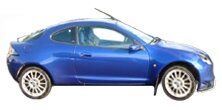
|
Production Run: |
500 |
|---|---|
|
Production Date: |
2000 - 2001 |
|
Engine: |
Ford 1.7 Zetec S 16v |
|
Built: |
Ford - Niehl (Germany) Tickford - Daventry (UK) |
|
0-60: |
7.8 Secs |
|
Max Speed: |
130 Mph |

The Ford Racing Puma was designed and engineered by the Ford Rally Team at Boreham in the UK. Powered by a modified 1.7 Zetec engine developing nearly 160 bhp the car was a sprightly performer and had good handling characteristic. Strictly a limited edition model Ford planned to produce 1,000 vehicles however this proved over optimistic and only 500 examples were ever produced between 2000 and 2001.
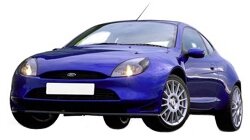
Ford Puma Racing
The original Ford Puma was released in 1997, the car was based on Ford’s B Platform (shared with the Ford Fiesta) and was a small, three door front wheel drive sports Coupe. Wanting to build on the success of the Puma, management approved the development of a performance derivative of the diminutive coupe. Engineering of the new vehicle was undertaken by the Ford Rally specialist team at Boreham in the UK under the leadership of Peter Beattie.
The Racing Puma was fitted with Ford’s 1.7 litre four cylinder 16v Sigma engine that was branded at the Zetec SE unit, the unit has a cast aluminium alloy cylinder block and cast aluminium alloy cylinder head. The engine was noted for including many features first introduced on this engine, examples of which are the plastic inlet manifold, ladder style main bearing and crankcase assembly and powder metal connecting rods. The engine was developed by Ford with involvement from Yamaha, the engine had a bore and stroke of 80mm x 83.5mm that gave a swept volume of 1,679cc.
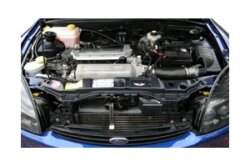
Ford Puma Racing Engine Bay
The power-plant used an evolution of the 1,596cc engine block, to extract additional power the engine was fitted with modified camshafts and a revised inlet manifold, breathing was improved through the installation of a tuned performance exhaust system and modified free flow catalytic converter. Fuel was delivered to the engine through a remapped Ford EEC-V engine management system that utilised a Sequential Electronic Fuel Injection System. The engine was fitted with Twin Independent Variable Camshaft Timing (Ti-VCT), with a compression ratio of 10.3:1 the engine developed 155 bhp @ 7,000 rpm and 119 lb/ft @ 4,500 rpm.
The Racing Puma retained the same body and chassis as the original Puma but did receive an overhaul to give a more aggressive stance. The car received wider front wings with flared arches constructed from Aluminium and wider steel rear wings with flared arches to accommodate the wider track and larger alloy wheels. The front and rear bumpers were replaced with newly designed units that included air cooling ducts and a front air splitter and revised front valance. The car also benefited from a revised from grille. All cars finished in Ford Racing Blue Metallic paint, the exterior modifications were neatly completed with the addition of 7.5 x 17” Speedline Alloy wheels fitted with Pirelli sourced P7000 215/40 tyres.
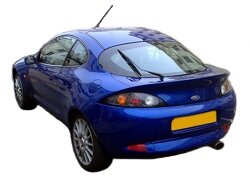
Ford Puma Racing Rear Shot
The car retained the original Ford Puma suspension setup utilising independent MacPherson struts at the front (these been up-rated with offset coil springs and dampers completed with an anti roll bar, the front track was widened by 35mm per corner. The rear suspension was courtesy of a semi independent twist beam with strut type up-rated coil springs and damper units with rear spacers, the rear track was also widened by 45mm per corner.
Stopping power was increased in line with the increased performance of the engine, the vehicle was fitted with servo assisted 295mm ventilated race specification Alcon discs at the front acted upon by four piston callipers and Mintex brake pads and 270mm solid discs at the rear. Braking was controlled with an electronic anti lock braking system. Steering remained standard with a variable ratio rack and pinion power assisted unit. Power was transferred from the engine to the front wheels through a viscous coupled limited slip differential. The Racing was fitted with a revised Ford B5 five speed manual gearbox that was fitted with closer ratios that more evenly matched the engine characteristics and longer driveshafts.
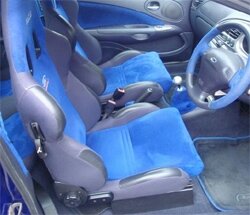
Ford Puma Racing Interior
Ford spent considerable effort upgrading the interior specification of the car, the original seats were replaced with Ford Racing Sparco seats trimmed in Alcantara with blue centre inserts. The rubber pedals were replaced with aluminium Sparco items increasing the visual appeal. Further modifications included the additional of a three spoke steering wheel trimmed with blue Alcantara fabric, the car retained the same dashboard as in the lesser specification models. The passenger cabin was well equipped with a quick clear heated front windscreen, electric windows, Ford 6000N CD player, air conditioning and airbag as standard. Extra’s that were fitted to this car as standard included power operated heated wing mirrors and a traction control system to effectively distribute power.
The vehicle had a significant boost in performance over its lesser Puma brothers, the 0-60 mph sprint took 7.8 seconds and the car was capable of reaching a top speed of 130 Mph, what made this more impressive was the combined fuel efficiency of 35 miles per gallon.
Production was split between Ford’s production facility at Niehl in Germany and Tickford Engineering plant in Daventry at the UK. The Racing Pumas were manufactured and painted at Fords plant before being shipped to Tickford in the UK. Upon arrival at Tickford the cars were standard Puma’s with standard wings, brakes and interior – the cars were shipped minus front and rear bumper and sat on standard steel wheels.
Tickford engineers removed the front and rear wings replacing them with the larger extended units, next the front brakes were replaced with the up-rated Alcon four piston units and the car was converted to have a rear disc braking setup. The standard exhaust was replaced with a Janspeed performance exhaust system and the car was fitted with the 17” alloy wheels. The interior was stripped down and replaced with the upgraded seats and steering wheel, the car was finished with the addition of the individual numbering on the revised inlet manifold. This was certainly not the most efficient method in which to manufacture a car and was a similar production method that was employed with the Tickford Capri some years previous.
Initially management had specified a production run of 1,000 vehicles with 500 right hand drive models destined for the UK, the remaining 500 were due to be left hand drive vehicles to be sold in the European market. This proved woefully optimistic and at the end of production only 500 examples had been manufactured. Priced at £23,000 the car did not prove as popular as had been anticipated perhaps due to the £7,000 price hike over the standard models, Ford even offered Racing Puma’s to management through their MRC scheme simple to shift the cars.
Today the Racing Puma is highly sought after by enthusiasts and collectors, a benefit of the reduced production volumes is that residual values of the Racing Puma are quite high with examples fetching at least £6,000, good examples can fetch as much as £10,000.
The Facts
|
Engine: |
Ford Zetec SE 16v (Ford Sigma) |
|---|---|
|
Capacity: |
1,679cc |
|
Valves: |
16 |
|
Compression Ratio: |
10.3:1 |
|
Fuel System: |
Ford EEC-V with Sequential Electronic Fuel Injection |
|
Maximum Power: |
155 bhp @ 7,000 rpm. |
|
Maximum Torque: |
119lb/ft @ 4,500 rpm. |
|
Transmission: |
Ford B5 5 Speed Manual |
|
Top Gear: |
- |
|
Brakes: |
Power Assisted 295mm Ventilated Front Alcon Discs with Mintex Pads / 270mm Solid Rear Discs |
|
Kerb Weight: |
1,174 Kg |
|
Max Speed: |
130 Mph |
|
0-60: |
7.8 Secs |






